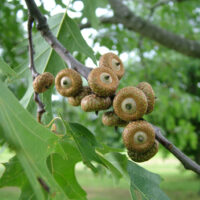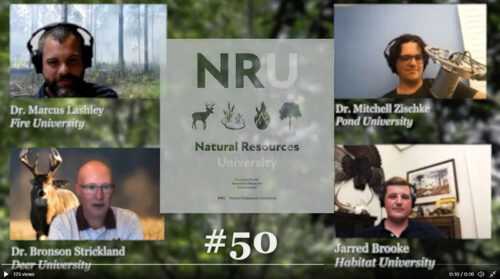 Purdue University - Extension - Forestry and Natural Resources
Purdue University - Extension - Forestry and Natural Resources
Got Nature? Blog
Explore the latest newsletter updates on the Indiana Woodland Steward website. Stay up-to-date with forestry news and receive their free e-newsletter by subscribing at IWS Subscribe.
Highlights from the new Newsletter include:
- An Interview with a Forester
by Dan Erst - “Why did you pursue a forestry career? I was a young college kid and really had no idea where I would potentially spend the rest of my life…”
- The EQIP program promotes native plant diversity in Indiana forests
by Aubrey Franks
“Invasion by non-native shrubs has negatively affected forests throughout the eastern United States. The onslaught of invasive shrubs, including…” - 2023 Outdoor Laboratory of the Year
by Ken Day
“Fishers Junior High School of Fishers, Indiana was selected as the 2023 Outdoor Laboratory of the Year. The award…” - 2023 Indiana Tree Farmer of the Year
by Ken Day
“Jeffrey and Jeanna Stout of Hagerstown, Indiana are the 2023 Indiana Tree Farmers of the Year. Their tree farm is…” - Deer Impact Toolbox: Helping Understand and Address Deer Impacts on Indiana Woodlands
by Jarred Brooke, Lenny Farlee, Elizabeth Jackson, Mike Jenkins, Caleb Redick, and Richard Sample
“When deer are overabundant, they negatively impact woodlands and forests in Indiana. Have you heard this statement before? Are deer having a negative…” - The Birders’ Dozen Profile 9: Eastern Whip-poor-will – Dr. Jessica Outcalt, consulting bird biologist
by Dr. Jessica Outcalt, consulting bird biologist
“Welcome to the Birders’ Dozen! Over the next four issues we are going to continue introducing the last few birds from…” - Enriching Log Landings to Benefit the Native Bees of Indiana
by Aliza Boles Fassler, Cheryl Coon, and Lauren Pile Knapp
“While everyone knows the European honey bee (Apis mellifera), many don’t know about the 430 species of native bees pollinating Indiana’s..” - Technology Corner – Merlin Bird ID App
“Merlin features the best of community contributed photos, songs, and calls, tips from experts around the world to help you ID the birds you see…” - Ask the Steward – Volume 2
By Dan Ernst
“Question: Are cicadas and locusts the same insect and are they edible?”
The Indiana Woodland Steward Newsletter is a resource offering a wealth of valuable information for foresters, woodland owners, timber marketing specialists, woodland and wildlife enthusiasts. The Indiana Woodland Steward Institute (IWS) is an entity made from 11 organizations within the state including Purdue University, Indiana Department of Natural Resources (DNR), and Indiana Hardwood Lumbermen’s Association (IHLA), that works to promote best usage practices of Indiana’s woodland resources through their Woodland Steward publication.
Resources
Hardwood Ecosystem Experiment – Wildlife Responses to Timber Harvesting, The Education Store, Purdue Extension resource center
Forest Improvement Handbook, The Education Store
Invasive plants: impact on environment and people, The Education Store
Managing Your Woods for White-Tailed Deer, The Education Store
Shrubs and Woody Vines of Indiana and the Midwest, The Education Store
Birds and Residential Window Strikes: Tips for Prevention, The Education Store
Breeding Birds and Forest Management: the Hardwood Ecosystem Experiment and the Central Hardwoods Region, The Education Store
Deer Impact Toolbox, The Education Store
Birdfeeder tips, The National Audubon Society
Managing Woodlands for Birds Video, Purdue Extension-Forestry and Natural Resources YouTube Channel
Subscribe: Deer, Forest Management, ID That Tree, Woodland Management Moment, Invasive Species and many other topic video playlists Purdue Extension-Forestry and Natural Resources YouTube Channel
Dan McGuckin, President
Indiana Woodland Steward
Dr. Brian MacGowan, Extension Wildlife Specialist
Department of Forestry & Natural Resources, Purdue University
Check out the new newsletter posts available by visiting the Indiana Woodland Steward website. Stay current in the world of forestry and receive their free e-newsletter by subscribing at IWS Subscribe.
 Highlights from the current Newsletter include:
Highlights from the current Newsletter include:
- 2023 Indiana Consulting Foresters Stumpage Timber Price Report
“This report is provided annually and is intended to be used as a general indicator of timber stumpage prices and activity in Indiana. There are many factors that determine the price of any individual timber sale…” - The Birders’ Dozen Profile 7: Eastern Screech-Owl
Dr. Jessica Outcalt, consulting bird biologist
“Welcome to the Birders’ Dozen! Over the next six issues we are going to continue introducing the last half of the bird species from Forestry for the Birds. The Birders’ Dozen are forest birds that…” - Forest Management is for the Birds!
by Judi Brown
“Saying something is “for the birds” can indicate frustration with a situation. But forest management’s effect on bird populations is…” - Flowering Dogwood
By Lenny Farlee
“Flowering dogwood is one of our most attractive small trees here in Indiana with beautiful white spring blossoms and very attractive fall red to maroon foliage. According to Native Trees of the Midwest, George Washington was…” - The PHiLL Project: A Collaboration of Forest Managers and Researchers to Restore Soils for Pollinator Benefits
By Cheryl Coon, Lauren Pile Knapp and John Kabrick
“Decline of native bees and how enriched log landings and increase habitat. Native bees are among the most diverse and important pollinators of our forested ecosystems with approximately 4,000 different species in North America…” - Ask the Steward
By Dan Ernst
“Question 1: I have not seen many squirrels this past winter. Do they migrate?” - Soil and Water Conservation District
“Woodland Steward Supporters 2023…”
The Indiana Woodland Steward Newsletter is a resource that’s full of a variety of valuable information to foresters, woodland owners, timber marketing specialists, woodland enthusiasts and wildlife enthusiasts. The Indiana Woodland Steward Institute (IWS) is an entity made from 11 organizations within the state including Purdue University, Indiana Department of Natural Resources (DNR), and Indiana Hardwood Lumbermen’s Association (IHLA), that works to promote best usage practices of Indiana’s woodland resources through their Woodland Steward publication.
Resources
Hardwood Ecosystem Experiment – Wildlife Responses to Timber Harvesting, The Education Store, Purdue Extension resource center
Forest Improvement Handbook, The Education Store
Invasive plants: impact on environment and people, The Education Store
Managing Your Woods for White-Tailed Deer, The Education Store
Shrubs and Woody Vines of Indiana and the Midwest, The Education Store
Birds and Residential Window Strikes: Tips for Prevention, The Education Store
Breeding Birds and Forest Management: the Hardwood Ecosystem Experiment and the Central Hardwoods Region, The Education Store
Deer Impact Toolbox, The Education Store
Birdfeeder tips, The National Audubon Society
Managing Woodlands for Birds Video, Purdue Extension-Forestry and Natural Resources YouTube Channel
Subscribe: Deer, Forest Management, ID That Tree, Woodland Management Moment, Invasive Species and many other topic video playlists Purdue Extension-Forestry and Natural Resources YouTube Channel
Dan McGuckin, President
Indiana Woodland Steward
Dr. Brian MacGowan, Extension Wildlife Specialist
Department of Forestry & Natural Resources, Purdue University
Tax preparation time usually brings with it questions about what is deductible, how to report this income, and what you can do to save on your taxes in the future. Fortunately for woodland owners, there are several excellent resources available to help you find some guidance.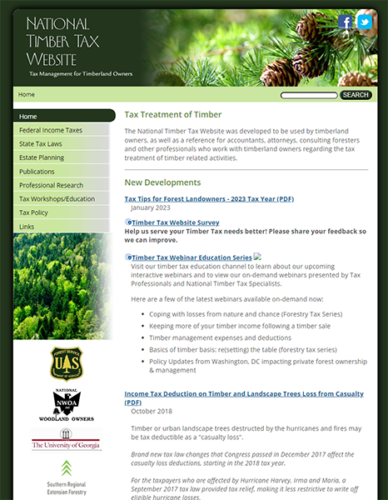
A national site addressing tax issues for woodland owners is the National Timber Tax Website. This site provides updated tax tips for the 2023 filing year, as well as many guides and references to help you effectively plan a tax strategy for your property.
The first link you will see on the National Timber Tax website is the recent timber tax tips by the U.S. Department of Agriculture (USDA), Forest Service:
Tax Tips for Forest Landowners: 2023 Tax Year (pdf 176KB)
Purdue Forestry and Natural Resources Extension offers some publications covering taxation issues for timber sales and tree planting.
How to Treat Timber Sale Income
Determining Tax Basis of Timber
Financial and Tax Aspects of Tree Planting
If you sold timber or planted trees for timber production last year, the references above may help you understand your options and possibly provide some tax savings.
Familiarizing yourself with the special treatment timber sales and tree plantings, which may be given in the tax code, can also help you more effectively plan for future tax returns.
Other resources:
U.S. Forest Service
The Education Store, Purdue Extension (place in search field: “timber”)
Lenny Farlee, Extension Forester
Hardwood Tree Improvement and Regeneration Center (HTIRC)
Forestry and Natural Resources, Purdue University
Forest Management for the Private Woodland Owner is a Purdue University short course providing knowledge and resources to help landowners make informed decisions in the care and management of their forests.
Topics covered include tree identification, forest history and biology, forest management planning, forest management practices, considerations for selling timber, forest investment and taxation, wildlife habitat management, and resources and assistance for private woodland owners.
In addition to previously announced courses (virtual and in-person near Wabash, Indiana), a third offering will be available near the Southern Indiana Purdue Agricultural Center (SIPAC) in Dubois, Indiana. (11371 E Purdue Farm Rd., Dubois, IN 47527)
This workshop, led by Purdue Extension forester Ron Rathfon, will be taught from Feb. 5 to March 25, 2024, at SIPAC on the north side of Patoka Lake near the dam entrance.
The course will include eight weekly meetings on Mondays from 6 p.m. to 9 p.m. ET, as well as two Saturday morning field tours, running from 9 a.m. to noon.
Class size is limited to 40 registrants on a first-come, first served basis. Register with easy printable, mail-in pdf, Forest Management of the Private Woodland Owner Course.
Registration cost is $50 per person and includes: in-person time with forestry specialists, all course materials, a thumb drive of all publications, a tree measuring stick and snacks. Guest registration (in addition to initial registration) is $30 and includes all learning sessions and handouts at the sessions.
Contact Ron Rathfon at ronr@purdue.edu or 812-678-5049 with any questions.
The Southern Indiana Purdue Ag Center is a 1,331 acre working farm and research and education facility designed to address practical farm and natural resource management problems providing practical solutions and education and training opportunities for farmers, landowners, foresters, and other natural resource professionals.
Purdue acquired the first piece of the property which became SIPAC in 1953 and additional forest acres were added in 1966 and 1967. Purdue FNR faculty and staff have taken an active role in management of the forest at SIPAC since 1953. The facility also has housed an extension forester since the mid-1960s.
Rathfon has served as a Purdue extension forester since 1992. He has taught the Forest Management for the Woodland Owners course since 1993.
Resources:
Forest Management for the Private Woodland Owner Course Program Impacts, Purdue Extension-Forestry and Natural Resources (FNR)
Forest Management for the Private Woodland Owner Course – Wabash County, Purdue Extension-FNR Events
Forestry Management for the Private Woodland Owner Course – SIPAC, Purdue Extension-FNR Events
Virtual Forest Management for the Private Woodland Owner Course, Purdue Extension-FNR Events
Forestry Management for the Private Woodland Owner Course – Jackson County, Purdue Extension-FNR Events
Cost Assistance for Landowners Planning Conservation Practices, Purdue Extension-FNR Got Nature? Blog
Woodland Stewardship for Landowners: EQUP, video, Purdue Extension-Forestry and Natural Resources (FNR) YouTube Channel
Woodland Stewardship for Landowners YouTube Playlist, Purdue Extension – FNR
Woodland Management Moment: Invasive Species Control Process, Purdue Extension – FNR Video
Woodland Management Moment YouTube Playlist, Purdue Extension – FNR
Invasive Species YouTube Playlist, Purdue Extension – FNR
What are invasive species and why should I care?, Got Nature? Blog, Purdue Extension – Forestry and Natural Resources
Report Invasive Species, Purdue Invasive Species
The GLEDN Phone App – Great Lakes Early Detection Network
EDDMaps – Early Detection and Distribution Mapping System
Hardwood Ecosystem Experiment: Uneven-aged Management, Purdue Extension – FNR Video
Finding help from a professional forester, Indiana Forestry & Woodland Owners Association
Forest Improvement Handbook, The Education Store, Purdue Extension resource center
Ron Rathfon, Regional Extension Forester, Southern Indiana Purdue Agriculture Center (SIPAC)
Purdue Forestry and Natural Resources
The Hardwood Tree Improvement & Regeneration Center (HTIRC) continues to share top forest research as scientists, experts and partners further the mission of tree improvement, management, and protection of hardwood forests. The most recent HTIRC Annual Report is now available and includes research, personnel and outreach: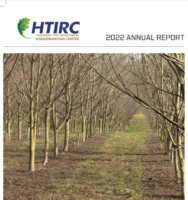
- HTIRC-Funded Research Grant Updates
- Center For Advanced Forestry Systems 2022
- Creating a Directory, Depository, and Database For Historical Genetic and Tree Improvement Trials
- Integrated Digital Forestry Initiative (iDiF)
- 2022 Operational Tree Improvement Report
Plus much more: HTIRC 2022 Annual Report.
If you would like to subscribe and receive the e-newsletter visit HTIRC e-Newsletter.
The mission of the HTIRC is to advance the science and application of tree improvement, management, and protection of hardwood forests, with emphasis in the Central Hardwood Forest Region (CHFR). They seek to develop research and technology-transfer programs that provide knowledge focused on the establishment and maintenance of sustainable, genetically diverse native forests and the development of highly productive woodlands that provide a wide array of products and services.
Other resources:
Purdue Entomology
Forestry & Natural Resources
Hardwood Tree Improvement & Regeneration Center (HTIRC)
Tropical HTIRC
An Introduction to Trees of Indiana, The Education Store, Purdue Extension resource center
Native Trees of the Midwest, The Education Store
Shrubs and Woody Vines of Indiana and the Midwest, The Education Store
ID That Tree, Playlist, Subscribe to Purdue Extension – Forestry and Natural Resources YouTube Channel
A Woodland Management Moment, Playlist, Purdue Extension – FNR YouTube Channel
Investing in Indiana Woodlands, The Education Store
Forest Improvement Handbook, The Education Store
Finding help from a professional forester, Indiana Forestry & Woodland Owners Association
Matthew Ginzel, Professor and Director of HTIRC
Purdue Entomology
Purdue University Department of Forestry and Natural Resources
Hardwood Tree Improvement and Regeneration Center (HTIRC)
The Natural Resources University podcast group received the gold award in the podcast or radio category from the Association of Natural Resource Extension Professionals (ANREP). The NRU podcast group includes the Habitat University podcast co-hosted by Purdue Extension wildlife specialist Jarred Brooke and Adam Janke, an extension wildlife specialist at Iowa State University.
“Receiving the ANREP Gold Award is an honor,” Brooke said. “What started as casual conversations amongst colleagues about creating science-based natural resources podcasts has blossomed into a podcast network with multiple unique podcasts and over 100 episodes. This collaboration has been a great avenue to get up-to-date science about natural resource management into landowners and managers’ hands (and ears).”
The NRU podcast group initially began with four science-based podcasts covering different aspects of natural resource management: Deer University, Pond University, Fire University and Habitat University.
Deer University, which is hosted by Dr. Bronson Strickland and Steve Demarais, focuses on the science of deer, including deer ecology, biology and management.
Pond University, which was co-hosted by FNR’s Mitch Zischke and Megan Gunn before ending its 11-episode run in August 2021, covered topics from pond habitat to fish stocking, vegetation control and pond construction.
Fire University, which is hosted by Dr. Marcus Lashley, covers the gamut of the latest research in fire ecology and how it relates to management of wildlife and plant communities.
Habitat University, hosted by Brooke and Janke, discusses the science behind wildlife habitat management and how landowners and manages can use different habitat management practices to improve their land for wildlife.
New to the NRU family in 2022-2023 are:
- Wild Turkey Science – Dr. Marcus Lashley and Dr. Will Gulsby bring you the latest research on wild turkey ecology and management
- Timber University – Dr. Brady Self and Dr. Shaun Tanger cover the latest research in timber management.
- Working Wild University – Dr. Alex Few and Dr. Jared Beaver immerse the listener in stories at the heart of the struggle to sustain productive, resilient and connect rural landscapes and communities.
- Fish University – Dr. Wes Neal covers the latest research in fish management from the small pond to the vast ocean.
The series housed within the NRU network aim to deliver expert-based knowledge for their corresponding genre of natural resource management. The network is a partnership between the extension services at several land-grant university, including Mississippi State Extension Service, University of Florida Extension, Iowa State University Extension and Outreach and Purdue Extension. Funding for the project comes from the Renewable Resources Extension Act.
The Natural Resources University podcasts are available through the individual podcast websites, through the NRU podcast main hub or wherever podcasts are available to download.
For full article and more photos view Purdue Forestry and Natural Resources News & Stories: Natural Resources University Podcasts Earn ANREP Gold Award .
More Resources:
Ask an Expert: Pond Management, Purdue Extension-Forestry & Natural Resources (FNR) YouTube playlist
Pond Management: Managing Fish Populations, The Education Store, Purdue Extension’s resource center
Yellow Perch Farmed Fish Fact Sheet, The Education Store
Frogs and Toads of Indiana, The Education Store
Snakes and Lizards of Indiana, The Education Store
Forest Improvement Handbook, The Education Store
Frost Seeding Native Grasses and Forbs with a Drone (UAV), Purdue Extension-FNR
Hardwood Ecosystem Experiment – Wildlife Responses to Timber Harvesting, The Education Store
Invasive Plants: Impact on Environment and People, The Education Store
Sustainable Communities, Purdue Extension
Ask the Expert: Turtles and Snakes video, Got Nature? post
ID That Tree, Purdue Extension-FNR YouTube playlist
Woodland Management Moment , Purdue Extension-FNR YouTube playlist
Wendy Mayer, FNR Communications Coordinator
Purdue University Department of Forestry and Natural Resources
Jarred Brooke, Wildlife Extension Specialist
Purdue Forestry and Natural Resources
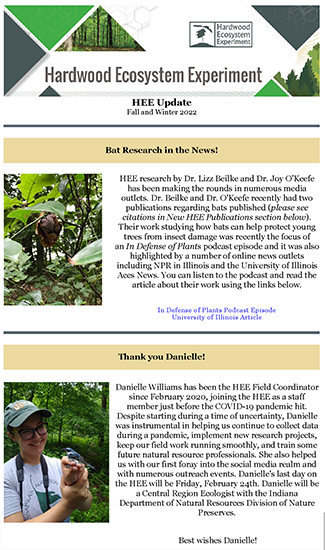 The Fall/Winter 2022 HEE Update newsletter is now available online. Research highlights and student news include:
The Fall/Winter 2022 HEE Update newsletter is now available online. Research highlights and student news include:
- Bat Research in the News
- Thank You Danielle
- We Are Hiring
- A Second HEE Departure
- Welcome New Graduate Students
- HEE Publications
“The HEE Update” is distributed to anyone interested in receiving updates on the Hardwood Ecosystem Experiment (HEE). The newsletter includes updates of field work, media attention, committee meetings, extension events, job announcements, publications, and presentations. Anyone can receive this newsletter. If you would like to be added to the newsletter list email Dr. Mike Saunders, associate professor of silviculture, Purdue Forestry and Natural Resources, at msaunder@purdue.edu.
What is HEE?
The focus of forest science is increasingly shifting to the management of forests as complex systems rather than as simple agricultural landscapes—with a much greater appreciation for the interactive ecosystem processes. In addition, now for many forest landowners, the ecological value of their land is at least as important as the economic return. It is, therefore, vital to understand how forest management affects not only timber production, but also the overall function of forested ecosystems.
The Hardwood Ecosystem Experiment (HEE) is a long-term, large-scale experimental study of forest management and its impacts. The project was initiated in 2006 with partners including: Ball State University, Drake University, Indiana State University, Purdue Entomology, Indiana Department of Natural Resources (IN DNR), and the Indiana Chapter of the Ruffed Grouse Society.
For information about study sites, harvesting treatments, sampling design, and more, see our Study Design page and US Forest Service General Technical Report NRS-P-108, The Hardwood Ecosystem Experiment: A Framework For Studying Responses to Forest Management.
Resources
Hardwood Ecosystem Experiment, Website
Hardwood Ecosystem Experiment (HEE), YouTube Playlist, Purdue Extension–Forestry and Natural Resources (FNR)
Prescribed Fire, Hardwood Ecosystem Experiment (HEE) YouTube Video
Ask an Expert: Hardwood Ecosystem Experiment (HEE) Birds and Salamander Research, Video, Purdue Extension-FNR YouTube Channel
Hardwood Ecosystem Experiment – Wildlife Responses to Timber Harvesting, The Education Store, Purdue Extension’s resource center
The Hardwood Ecosystem Experiment: Indiana Forestry and Wildlife, The Education Store
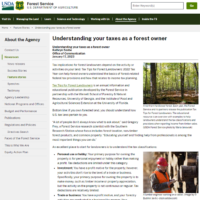 Tax preparation time usually brings with it questions about what is deductible, how do I report this income, and what can I do to save on my taxes in the future. Fortunately for forest landowners, this resource for tax tips from the U.S. Department of Agriculture-Forest Service provides several excellent resources to help you find some guidance. View Understanding Your Taxes as a Forest Owner.
Tax preparation time usually brings with it questions about what is deductible, how do I report this income, and what can I do to save on my taxes in the future. Fortunately for forest landowners, this resource for tax tips from the U.S. Department of Agriculture-Forest Service provides several excellent resources to help you find some guidance. View Understanding Your Taxes as a Forest Owner.
The National Timber Tax Website, which is also shared in this article, addresses tax issues for forest landowners. This site provides updated tax tips for the 2022 filing year, as well as many guides and references to help you effectively plan a tax strategy for your property.
The USDA Forest Service mission of sustaining the health, diversity and productivity of the nation’s forests and grasslands to meet the needs of present and future generations, continues on as they provide many resources including managing your land, science and technology, and working with the U.S. Forest Service.
More resources: Purdue Extension – Forestry and Natural Resources offers some publications covering taxation issues for timber sales and tree planting.
How to Treat Timber Sale Income, The Education Store, Purdue Extension’s resource center
Determining Tax Basis of Timber, The Education Store
Financial and Tax Aspects of Tree Planting, The Education Store
The Education Store (for a list of all timber resources or woodlands place in search field: “timber” or “woodlands”)
Classified Forest and Wildlands Program , Indiana Department of Natural Resources: Division of Forestry
Find an Indiana Professional Forester, Indiana Forestry & Woodland Owners Association (IFWOA)
You may have many reasons why you want to plant trees on your land and this webinar Conservation Tree Planting will help you as you define your objectives and plan your planting. This webinar explains the difference between conservation tree planting and ornamental or landscape tree planting. The research based techniques and resources shared will help guide you as you work toward meeting your goals.
Lenny Farlee, Purdue extension forester, discusses topics including:
- reforestation
- tree species
- growth rates
- ordering seedlings
- weed control/herbicides
- equipment
- erosion control
- windbreaks
- soil health
- post-planting care/thinning
- fencing options
- wildlife habitat management
We Want to Hear From You:
After you have viewed the webinar please fill out the Qualtrics Survey and let us know if the video was helpful.
Resources:
Resources and Assistance Available for Planting Hardwood Seedlings, The Education Store, Purdue Extension’s resource center
Creating a Wildlife Habitat Management Plan for Landowners, The Education Store
Planting Forest Trees and Shrubs in Indiana, The Education Store
Forest Improvement Handbook, The Education Store
How to Build a Plastic Mesh Deer Exclusion Fence, The Education Store
Woodland Stewardship for Landowners Purdue Extension – Forestry & Natural Resources (FNR) Extension YouTube Playlist
Woodland Management Moment, Purdue Extension – FNR YouTube Playlist
Lenny Farlee, Sustaining Hardwood Extension Specialist
Purdue University Department of Forestry and Natural Resources
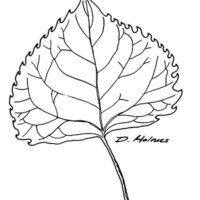 The classic and trusted book “Fifty Common Trees of Indiana” by T.E. Shaw was published in 1956 as a user-friendly guide to local species. Nearly 70 years later, the publication has been updated through a joint effort by the Purdue Department of Forestry and Natural Resources, Indiana 4-H, and the Indiana Department of Natural Resources, and reintroduced as “An Introduction to Trees of Indiana.”
The classic and trusted book “Fifty Common Trees of Indiana” by T.E. Shaw was published in 1956 as a user-friendly guide to local species. Nearly 70 years later, the publication has been updated through a joint effort by the Purdue Department of Forestry and Natural Resources, Indiana 4-H, and the Indiana Department of Natural Resources, and reintroduced as “An Introduction to Trees of Indiana.”
The full publication is available for download for $7 in the Purdue Extension Education Store. The field guide helps identify common Indiana woodlot trees.
Each week, the Intro to Trees of Indiana web series will offer a sneak peek at one species from the book, paired with an ID That Tree video from Purdue Extension forester Lenny Farlee to help visualize each species as it stands in the woods. Threats to species health as well as also insight into the wood provided by the species, will be provided through additional resources as well as the Hardwoods of the Central Midwest exhibit of the Purdue Arboretum, if available.
This week, we introduce the Cottonwood or Populus deltoides.
This large bottomland tree’s scientific name deltoides comes from the delta shape of the leaves, which are triangular, often with prominent teeth that resemble saw blades along the edges. This species is also named for its early season fruit, which is a little tuft of white hairs that holds a small seed and is produced in large quantities and often blown far from the parent tree.
Leaves, which are bright green on top and paler below, extend from long flattened leaf stems, which allow the leaves to flutter in the wind. The bark of young cottonwoods is smooth and yellow-green; the old bark is medium gray/brown and rough, with thick, flat ridges that run up and down the trunk.
This tree is found in moist river bottoms and stream bottoms and areas where there is flooding and new soil is created. It shades the streams, holds the soil in place on river bottoms and provides diversity to Indiana forests. Cottonwood is found from Saskatchewan through the Great Plains and east to the Appalachians and the southeast coastal plains.
This species grows rapidly and can be well over 100 feet in height and as large as three or foot feet in diameter.
The wood of eastern cottonwood is very soft, but is strong for its weight. At 12 percent moisture content, it weighs 28 pounds per cubic foot, making it one of the lightest commercially available woods.
For full article with photos view: Intro to Trees of Indiana: Cottonwood
Resources:
Eastern Cottonwood, Tour Hardwoods of the Central Midwest
Eastern Cottonwood – Purdue Arboretum
Fifty Common Trees of Indiana
An Introduction to Trees of Indiana
Native Trees of the Midwest, The Education Store, Purdue Extension’s resource center
Shrubs and Woody Vines of Indiana and the Midwest, The Education Store
ID That Tree, Purdue Extension-FNR’s YouTube playlist
Woodland Management Moment , Purdue Extension-FNR’s YouTube playlist
Investing in Indiana Woodlands, The Education Store
Forest Improvement Handbook, The Education Store
Wendy Mayer, FNR Communications Coordinator
Purdue University Department of Forestry and Natural Resources
Lenny Farlee, Sustaining Hardwood Extension Specialist
Purdue University Department of Forestry and Natural Resources
Recent Posts
- Announcing-New Indiana Woodland Steward Newsletter
Posted: September 2, 2024 in Forestry, Timber Marketing, Wildlife, Woodlands - New Indiana Woodland Steward Newsletter, Your Forest and Wildlife Resource
Posted: May 7, 2024 in Timber Marketing, Wildlife, Woodlands - Tax Information For Woodland Owners
Posted: January 25, 2024 in Forestry, How To, Timber Marketing, Woodlands - Forest Management for the Private Woodland Owner – SIPAC
Posted: November 17, 2023 in Forestry, How To, Invasive Plant Species, Timber Marketing, Woodlands - HTIRC Protecting Our Hardwood Forests
Posted: August 2, 2023 in Forestry, Timber Marketing, Woodlands - Natural Resources University Podcasts Earn ANREP Gold Award
Posted: April 14, 2023 in Podcasts, Ponds, Timber Marketing, Wildlife, Woodlands - 100 Year Project Newsletter, Hardwood Ecosystem Experiment (HEE)
Posted: March 8, 2023 in Forestry, Timber Marketing, Wildlife, Woodlands - Forest Landowners Will Want to View U.S. Forest Service Resource
Posted: February 9, 2023 in Forestry, How To, Timber Marketing, Woodlands - Conservation Tree Planting: Steps to Success
Posted: February 3, 2023 in Forestry, Timber Marketing, Webinar, Wildlife, Woodlands - Intro to Trees of Indiana: Cottonwood
Posted: June 30, 2022 in Forestry, Forests and Street Trees, Timber Marketing, Woodlands
Archives
Categories
- Alert
- Aquaculture/Fish
- Aquatic/Aquaculture Resources
- Ask the Expert
- Christmas Trees
- Community Development
- Disease
- Drought
- Forestry
- Forests and Street Trees
- Gardening
- Got Nature for Kids
- Great Lakes
- How To
- Invasive Animal Species
- Invasive Insects
- Invasive Plant Species
- Land Use
- Natural Resource Planning
- Nature of Teaching
- Plants
- Podcasts
- Ponds
- Publication
- Safety
- Spiders
- Timber Marketing
- Uncategorized
- Urban Forestry
- Webinar
- Wildlife
- Wood Products/Manufacturing
- Woodland Management Moment
- Woodlands
